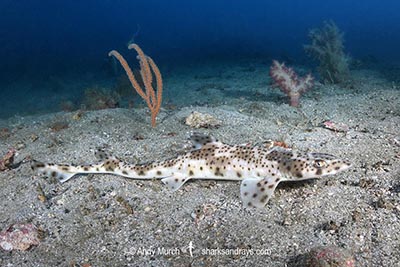Common names
Blackspotted Catshark, Darkspotted Catshark.
Binomial
Halaelurus buergeri.
Synonyms
Halaelurus burgeri, Scyllium buergeri.
Identification
Somewhat slender body. Snout dorsally compressed with pointed tip. Eyes/brows raised slightly above head. Mouth width greater than snout length. Labial furrows short. Gills short, positioned on upper body. First dorsal origin slightly anterior to pelvic fin insertion. Second dorsal fin origin over anal fin insertion. Pectoral fin apices rounded. Lower caudal lobe long and straight. Upper caudal lobe rounded.
Dorsal coloration light greyish brown with diffuse reddish brown saddles bordered in irregulaur small black spots. Ventrum pale.
Size
Maximum length 49cm. Size at birth unknown.

Conservation Status
ENDANGERED
The Blackspotted Catshark (Halaelurus buergeri) catch data in Taiwan indicates that the population has remained stable over the last 15 years, but declines have occurred in Japan where it was once common. There is intensive fishing pressure across its entire range, but seasonal fishing bans in Taiwan and China may offer the darkspotted catshark some respite.

Habitat
A warm-temperate water species inhabiting sandy areas sometimes around reefs. From 25-100m.
Distribution
The Blackspotted catshark is found in the western Pacific and South China Sea, off the coasts of Japan, Korea, China, Taiwan, The Philippines, and northwestern Borneo. Possible records from Thailand require confirmation.
Reproduction
Oviparous. Egg cases are retained in the oviduct until close to hatching.
Diet
Probably feeds on benthic invertebrates.
Behavior
Avoids predators by partially burying its mid-body in soft substrates; a behavior demonstrated in image Blackspotted Catshark 002.
Reaction to divers
Often remains stationary for a short time before bolting from divers.
Diving logistics
The Blackspotted Catshark is rarely seen by divers, but it is occasionally encountered near Ushibuka in Kyushu Island, Japan.
Similar species
Graceful Catshark Distinguished by more forward position of first dorsal fin and more uniformly distributed black spots.


